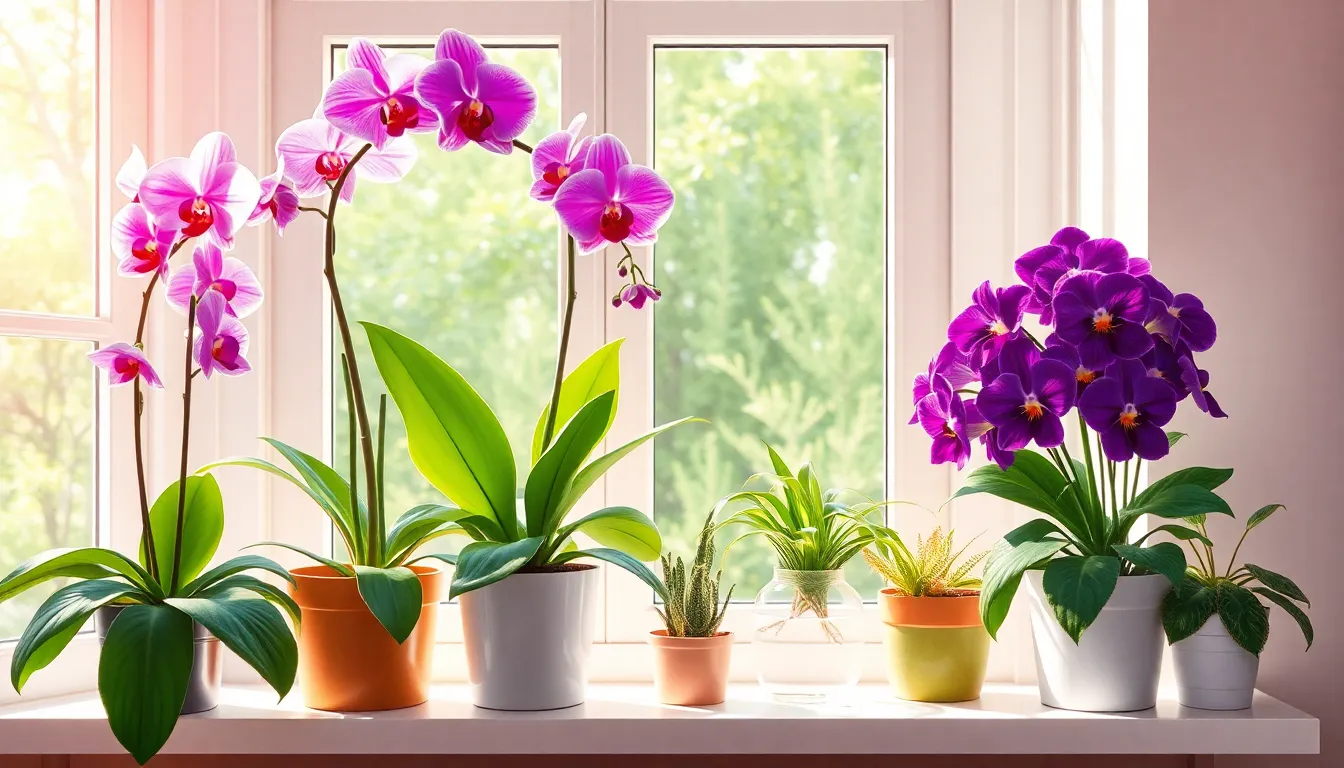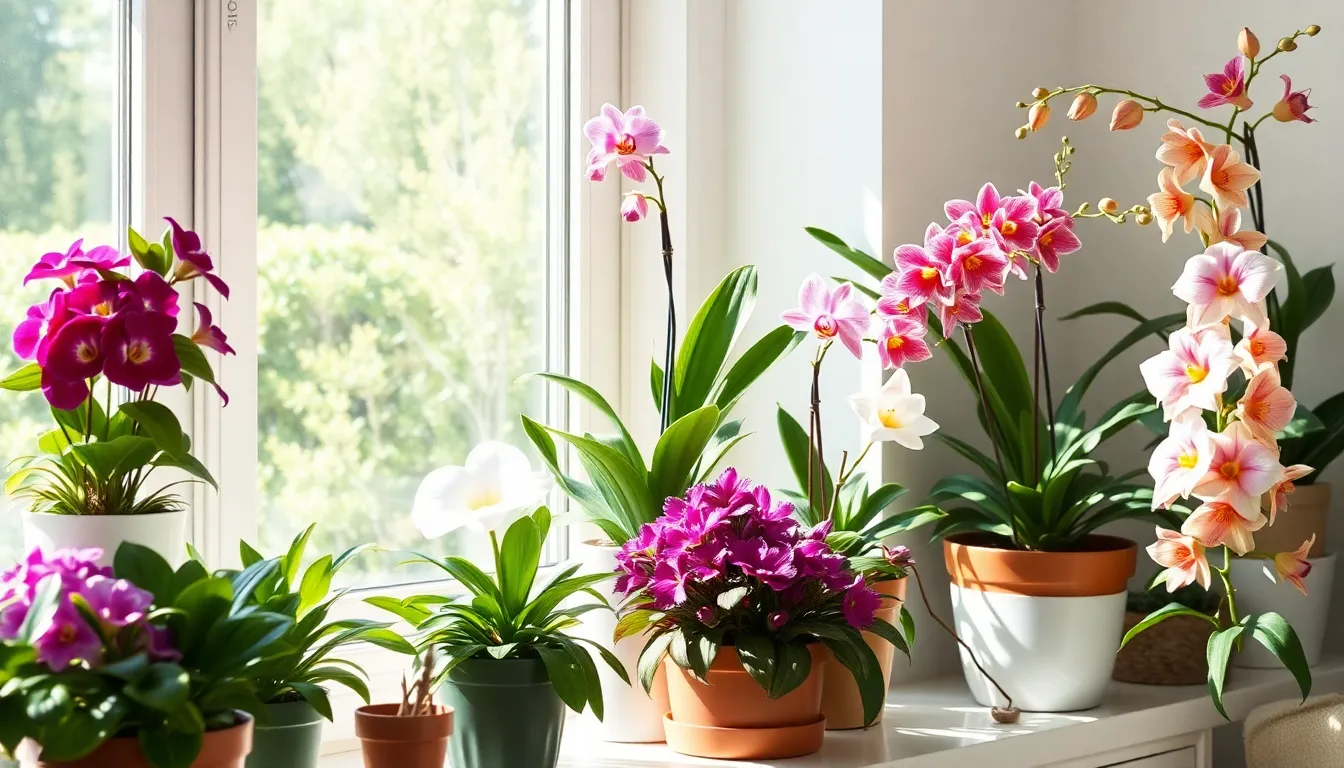Imagine transforming your home into a vibrant oasis, where the air is filled with color and the scent of blooming flowers dances through the rooms. Flowering houseplants are not just pretty faces; they bring joy, freshness, and a touch of nature right into your living space. Plus, they’re the perfect conversation starters—who wouldn’t want to chat about that stunning orchid or the cheeky little African violet?
Flowering Houseplants
Flowering houseplants bring vibrant colors and delightful scents into living spaces. Varieties include African violets, orchids, and peace lilies, each offering unique blooms and characteristics. Many of these plants thrive indoors, adapting well to various light conditions.
Benefits encompass enhanced air quality, improved mood, and added aesthetic appeal. Studies show that plants like the geranium can reduce stress and boost creativity. Care requirements differ among species, ranging from moderate to high maintenance.
water requirements can vary; for example, peace lilies prefer consistently moist soil, while succulents generally need less frequent watering. Light needs also differ; orchids flourish in bright, indirect light, while some flowering plants tolerate lower light conditions.
Placement matters when selecting a flowering houseplant. Putting them near windows ensures they receive adequate sunlight. Grouping different species together can create a striking display, enhancing overall decor.
Pest management should not be overlooked. Regularly inspecting leaves for signs of infestation can help maintain plant health. Many flowering houseplants are susceptible to common pests like aphids and spider mites.
Awareness of seasonal care tips contributes to their longevity. Plants such as chrysanthemums may require dormancy periods after flowering to thrive in subsequent growing seasons. Fertilization schedules can enhance blooming frequency, ensuring a colorful display year-round.
Benefits of Flowering Houseplants

Flowering houseplants provide various advantages that enhance living spaces. These plants improve ambiance and contribute significantly to home aesthetics.
Aesthetic Appeal
Colorful blooms add vibrancy to indoor environments. Each flowering houseplant, from the delicate orchid to the cheerful African violet, offers unique visual elements. Bright flowers create focal points that attract attention and spark conversations. Arrange plants in different heights and pots for added interest. The seasonal changes in blooms ensure a continuously evolving scenery. Flowering houseplants not only beautify homes but also provide emotional uplift through their presence.
Air Purification
Certain flowering houseplants actively improve air quality. Research indicates species like peace lilies and gerbera daisies help filter toxins from indoor environments. These plants absorb harmful substances and release oxygen, promoting healthier air. Enhancing indoor air quality can lead to increased well-being and improved cognitive function. Place flowering houseplants in various rooms to maximize their purifying effects. The benefits extend beyond aesthetics, contributing to a healthier living space.
Popular Types of Flowering Houseplants
Flowering houseplants bring vibrant energy into homes. Each type displays unique characteristics and care needs that cater to various preferences.
African Violets
African violets feature velvety leaves and charming blooms in multiple colors. These plants thrive in moderate indirect light, which promotes healthy growth. Watering should occur when the soil surface feels dry, avoiding water on leaves to prevent rot. Fertilizing with a balanced formula every few weeks ensures continual blooming. African violets are ideal for windowsills, where they can soak in gentle sunlight while brightening up any room.
Peace Lilies
Peace lilies are known for their elegant white flowers and glossy green leaves. Optimal growth occurs in low to medium light conditions, making them versatile for indoor spaces. Keep the soil moist but not soggy; water when the top inch feels dry. Regular fertilization during the growing season boosts both foliage and flower production. Placing peace lilies in bedrooms or living areas allows them to purify air, contributing to a healthier atmosphere.
Orchids
Orchids stand out with their exotic blossoms and diverse patterns. Bright, indirect light is essential for their growth, as direct sunlight can scorch their leaves. Watering should involve soaking the potting medium, letting it dry slightly between sessions. Fertilizing with a specialized orchid mix encourages robust blooming and vibrant colors. Orchids make striking statement pieces in any room, captivating attention with their unique shapes and enticing fragrance.
Care Tips for Flowering Houseplants
Caring for flowering houseplants requires attention to their specific needs. Understanding their requirements helps ensure healthy growth and vibrant blooms.
Light Requirements
Flowering houseplants often thrive in bright, indirect light. Placing them near east or west-facing windows provides optimal conditions. Some species may tolerate low light but typically produce fewer flowers. African violets, for example, prefer moderate light without direct sun exposure. Orchids benefit from bright, filtered light, while peace lilies can survive in lower light. It’s essential to rotate these plants occasionally to promote even growth and prevent leaning toward the light source.
Watering Techniques
Watering techniques for flowering houseplants depend on the species and environmental conditions. Allowing the soil to dry slightly between waterings promotes root health. Overwatering can lead to root rot, so checking soil moisture helps avoid this issue. Aiming for consistent moisture works well for peace lilies, while African violets prefer watering from the bottom. Watering in the morning minimizes evaporation and ensures the plant receives adequate hydration throughout the day. Some flowering houseplants also benefit from occasional misting to maintain humidity levels.
Fertilization
Fertilization plays a significant role in promoting blooms for flowering houseplants. Using a balanced, water-soluble fertilizer during the growing season enhances flowering frequency. Monthly applications generally suffice, while reducing fertilization in the fall and winter supports dormancy. Diluting the fertilizer to half strength prevents nutrient burn, ensuring healthy growth. Specific plants, like orchids, may require specialized formulations tailored to their needs. Observing your plant’s response to fertilization allows for better adjustments and improves overall health.
Conclusion
Incorporating flowering houseplants into a home can transform any space into a vibrant oasis. Their colorful blooms and delightful fragrances create an inviting atmosphere that uplifts spirits and sparks conversations. With a variety of species to choose from each offering unique beauty and air-purifying benefits there’s a perfect match for every lifestyle.
Understanding the specific care needs of these plants ensures they thrive and continue to enhance indoor environments. By paying attention to light, watering, and fertilization, anyone can enjoy a flourishing display of blooms year-round. Flowering houseplants not only beautify spaces but also contribute to overall well-being, making them an invaluable addition to any home.

